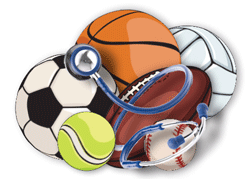Coaches, Athletic Directors, and Team Healthcare Providers
5 Steps to Take if You Think an Athlete Might Have a Skin Infection 
- Refer athletes with possible infections to a healthcare provider such as team physician, athletic trainer, school nurse, or primary care doctor.
- If the athlete is younger than 18 years old, notify parents/guardians about the possible infection.
- Instruct the athletes with a potential or confirmed infection or open wound to avoid using whirlpools or therapy pools not cleaned between athletes and other common-use water facilities like swimming pools until infections and wounds are healed.
- Review and implement cleaning and disinfecting guidance: Environmental Cleaning & Disinfecting for MRSA.
- Educate athletes about ways to prevent spreading the infection.
- Refer athletes to the Information & Advice for Athletes page.
- Make sure supplies are available to comply with prevention measures (e.g., soap in shower and at sinks, bandages for covering wounds, hand hygiene such as alcohol-based hand rubs).
- Make sure athletes:
- keep wounds covered and contained
- shower immediately after participation
- shower before using whirlpools
- wash and dry uniforms after each use
- report possible infections to coach, athletic trainer, school nurse, other healthcare providers, or parents.
- Using the criteria above, consider excluding the athlete from participation until evaluated by a healthcare provider.
Recommended Practices for Treating Athletes with Skin Infections
National MRSA Education Initiative

Educational materials for coaches and athletes.
- Use Standard Precautions, including hand hygiene before and after contact and after removing gloves, when caring for non-intact skin or possible infections.
- If hands are not visibly dirty and no sinks are available for hand washing (for example, while on the field) alcohol-based hand rubs and sanitizers can be used to improve hand hygiene.
- Ensure infected wounds on athletes are properly covered.
- Encourage athletes to cover acute, non-infected wounds (e.g., abrasions, blisters, lacerations) until healed to prevent infection.
Excluding Athletes with MRSA Infections from Participation
- If sport-specific rules do not exist, in general, athletes should be excluded if wounds cannot be properly covered during participation.
- The term “properly covered” means that the skin infection is covered by a securely attached bandage or dressing that will contain all drainage and will remain intact throughout the activity. If wounds can be properly covered, good hygiene measures should be stressed to the athlete such as performing hand hygiene before and after changing bandages and throwing used bandages in the trash.
- A healthcare provider might exclude an athlete if the activity poses a risk to the health of the infected athlete (such as injury to the infected area), even though the infection can be properly covered.
- Athletes with active infections or open wounds should not use whirlpools or therapy pools not cleaned between athletes and other common-use water facilities like swimming pools until infections and wounds are healed.
- Page last reviewed: August 25, 2015
- Page last updated: April 14, 2016
- Content Source:


 ShareCompartir
ShareCompartir